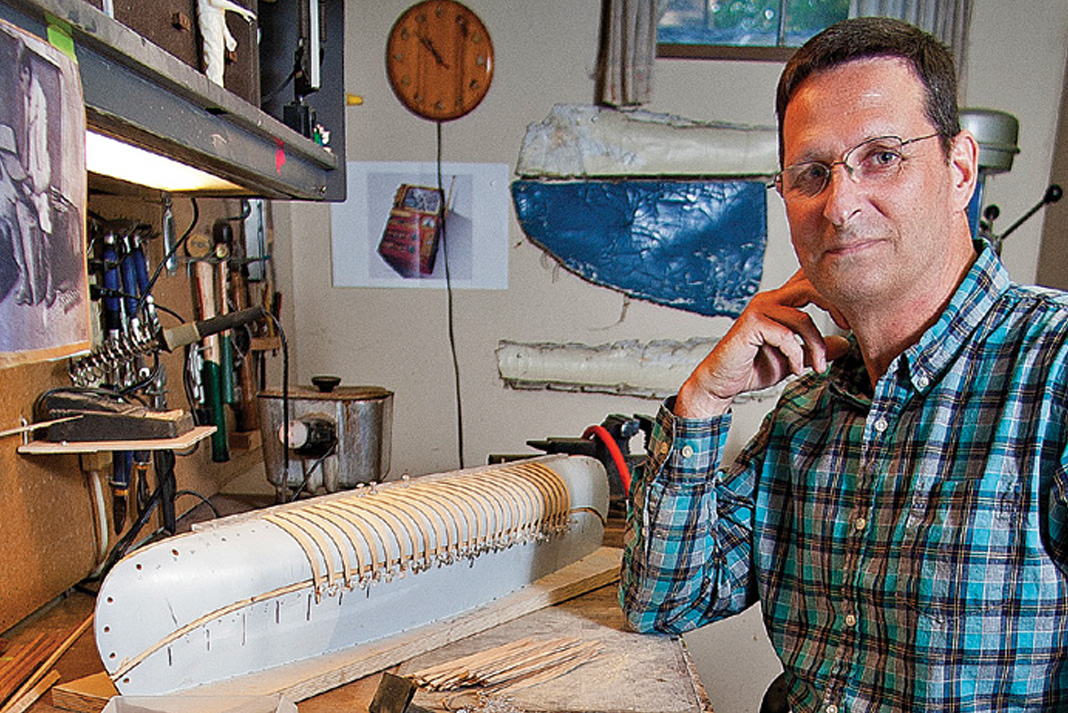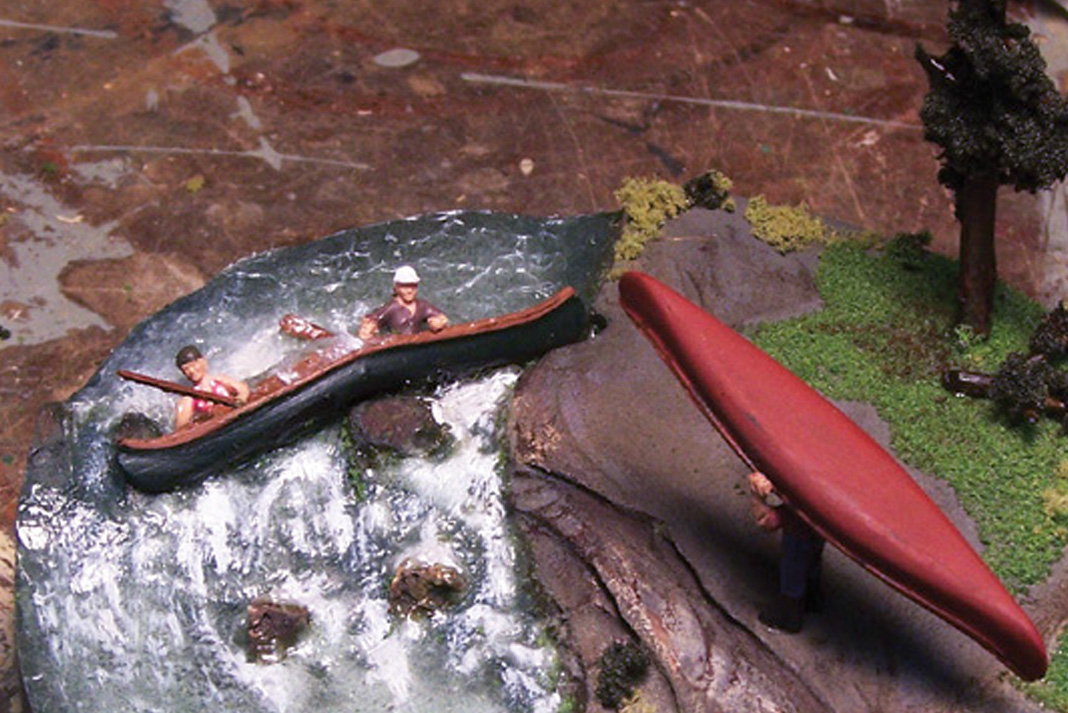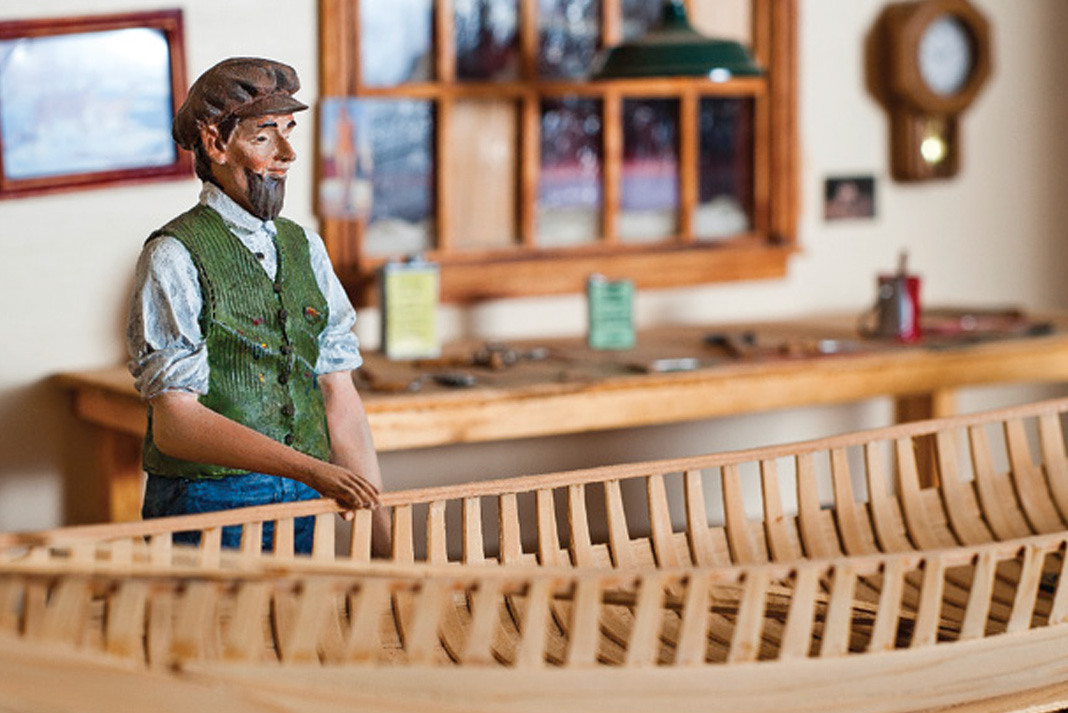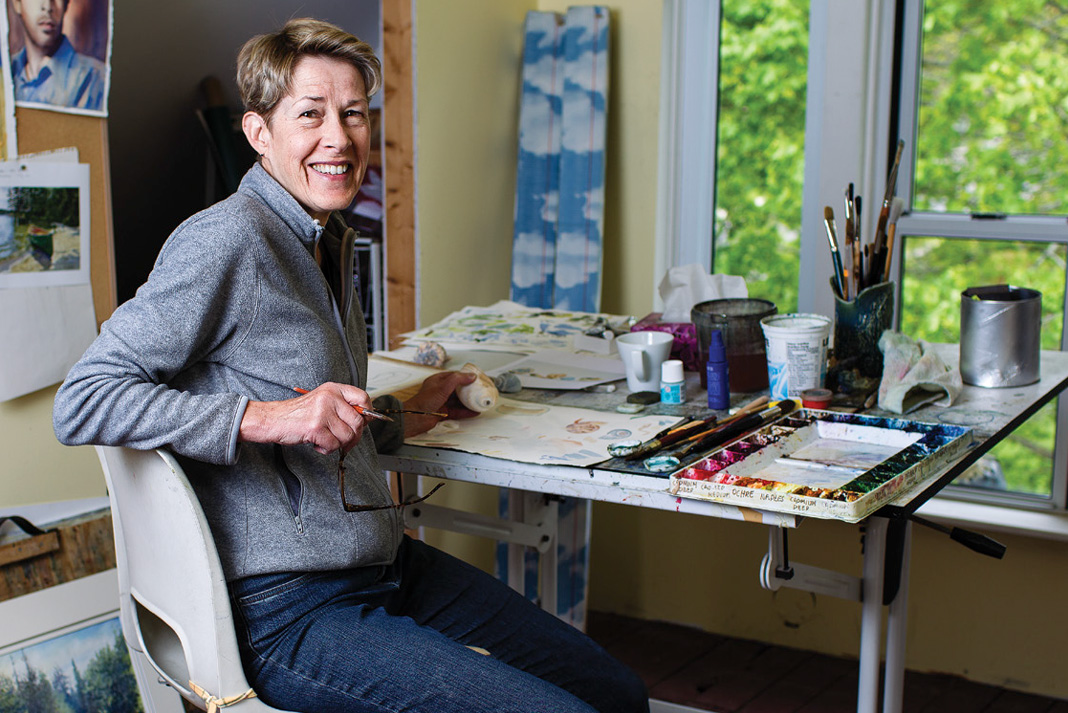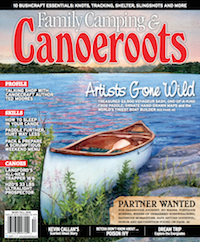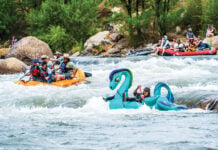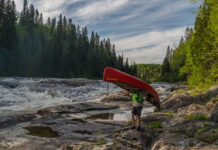From Painters And Carvers, To Weavers & Mapmakers, Meet Six Acclaimed Artists Inspired By The Path Of The Paddle
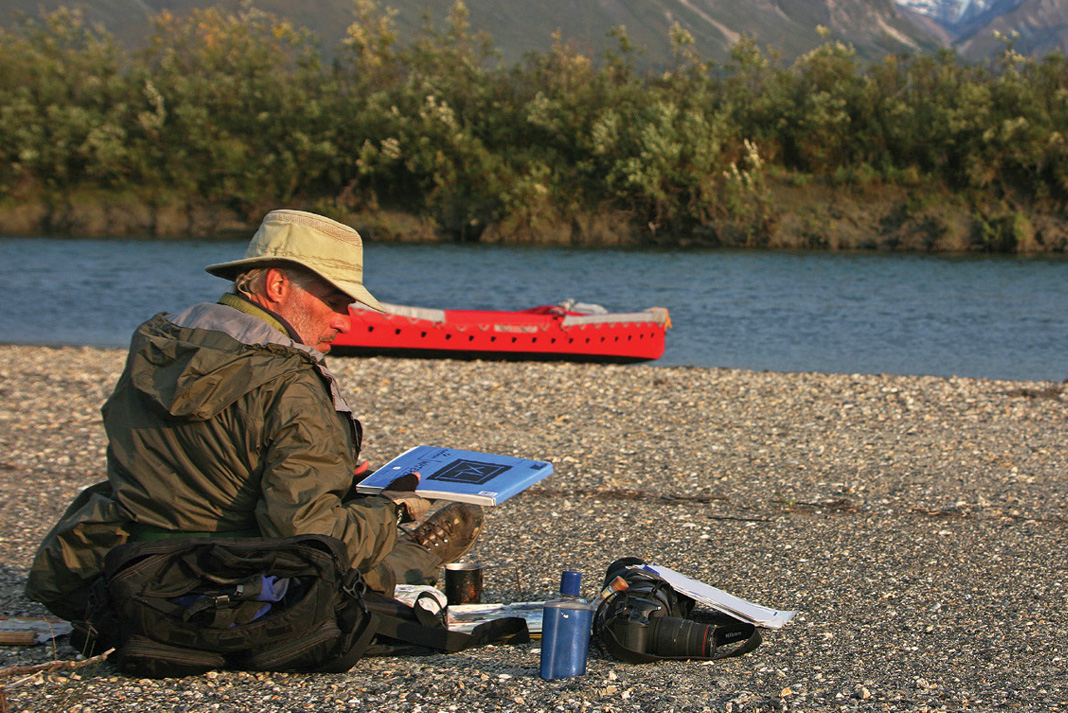
The Expedition Painter
Rob Mullen
When Rob Mullen flies into Minakokosa Lake late this summer, about 10 miles north of the Kobuk River in northwest Alaska, he’ll have his painting boards and a field kit with acrylic paints, brushes, pens, pencils and pallets. The small supplies backpack will be stowed with his other expedition gear in the canoe. Opportunity is everything for wilderness artists, he says.
“I may not use all of them, but I will do lots of sketches,” says Mullen. The award-winning owner of Paint n’ Paddle Studio in Bolton, Vermont, Mullen is also the executive director of the Wilderness River Expedition Art Fellowship, a non-profit he founded in 2005 to encourage what he calls, “the art of conservation.”
Each summer, Mullen invites a small group of artists to immerse themselves in nature on wilderness paddling journeys. Thirty, including renowned wildlife artist, Robert Bateman, have joined him over the years.
“On tough trips I may not get a lot of work done because I’m exhausted,” Mullen explains. “On a 2013 trip (to Alaska) I got four paintings done the entire time. But if something grabs me and is inspirational, and on solo trips especially, I’ll pull over and paint.”
Mullen’s Alaskan foray this season completes a three-year, 900- mile circumnavigation of the western Brooks Range by canoe with other artists. The route began on the Noatak River in 2012. The group finishes on the Kobuk River this year, having paddled 350 miles to Kotzebue, Alaska, on the coast of the Chukchi Sea. It is Mullen’s 16th art expedition organized to highlight Boreal forest conservation.
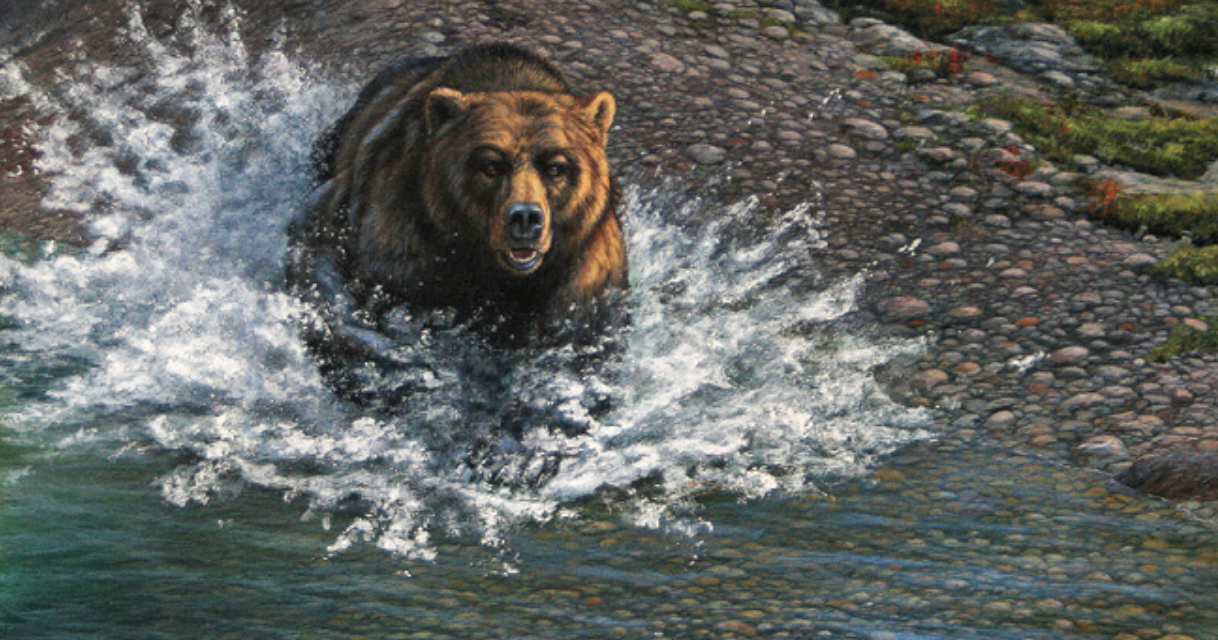
“Canoeing and painting are both a way of exploring wilderness,” says Mullen, who spent 16 years in New York City working as a freelance commercial artist before having a change of heart. He left the city in 1994 to return to Vermont, where he grew up.
“I did cigarettes, cosmetics and booze. The work was mind- numbing,” Mullen exclaims. “So, I’d go on big canoe trips. They were my tonic from Manhattan advertising.”
“Doing wilderness art is my way of trying to remind people that we are part of nature. Canoeing has been the heart and soul of my work,” he adds.
It also nearly got him in trouble in 2013 when Mullen was charged by a grizzly bear while on the Reed River in Alaska. The charge forced Mullen to put a warning shot by the bear’s ear. He later painted the scene.
A self-taught artist, Mullen began drawing as a child. He got his college degree in biology, planning to become a biological illustrator, but the money was too good in Manhattan, “A lion’s den of intense pressure,” he calls it.
That ability to produce under pressure aids him as an artist in the bush today. The Alaskan tundra can be a tough place to paint. High winds and rain can be a problem. The bugs, he says, are brutal.
“You can pick a sheltered spot to deal with the wind, and you can get under a tarp in the rain, but bugs are a huge problem,” Mullen says. “They get in your face and then into your paint.”
See more of Rob Mullen’s work at paintnpaddlestudio.com.
The Model Maker
Chris Pearson
Chris Pearson’s love for canoes began as an eighth-grade boy on a church camp canoe trip. It’s never waned. A 16- foot Kevlar Mad River Explorer hangs in his garage today. He speaks of it fondly, having paddled it to James Bay on the Missinaibi River.
But Pearson believes he was born 100 years too late. He swoons sentimentally about old wood and canvas canoes, five of which also sit in his garage. It’s down in his basement sanctuary and wood shop that his affinity for canoes truly becomes apparent. Amid antique lanterns and North Woods paraphernalia sit four immaculate models of historic wooden canoes he painstakingly researched and built.
“Building these blends two of my life loves together: the art of canoes and working to scale with my hands. I love the feel of wood and the smell of it,” exclaims Pearson, a professional model builder in the automotive industry. He built his first miniature canoe in 1989 while recuperating from back surgery.
Pearson’s works are sought by paddlers and non-paddlers, art lovers and collectors. One was displayed at the Canadian Canoe Museum in 2008, part of an exhibit called “The Canoe in Miniature.” To date, he’s built 75 for paying clients who also buy his miniature dioramas, which depict canoe-related scenes.
A 1/8th scale replica of an E.M. White Sport, named Carlotta after his grandmother, sits perched in a woodsy diorama on a shelf in his basement. Each tiny boiled rib and woven cane seat appears as they would have on a full-sized White in the late 1800s when the Maine canoe maker was producing them. Pearson’s miniature Racine canoes replicate early 1900s Wisconsin designs, but his favorite is the larger, 1/5th scale E.H. Gerrish.
Evan Gerrish began building canoes in Bangor, Maine, in the 1800s. Historians credit him with the first commercial wood and canvas designs that evolved from birch bark canoes, but retained certain traditional elements. Gerrish used cane wrappings, for example, to simulate spruce root wrappings found on Native canoes.
“My favorite, by far, is my Gerrish. It’s so elemental,” says Pearson.
His fascination with miniatures blossomed on a grade school trip to a museum in Rochester, New York, where he saw an Iroquois Indian diorama. “Seeing that did something to me; it was cool,” Pearson says. “That’s how I got into model making.”
Forty to 60 hours are required to build each of Pearson’s models; they sell for $800 to $2,000.
Pearson’s dioramas are often built inside Coleman lanterns or on top of Coleman camping stoves. A favorite is “Fresh Off The Form,” a shelf-mounted look at a 1930s era canoe builder’s shop. Inside are a partially complete canoe, a tiny craftsman, and his tools. On the wall is a no smoking sign, a girl in bathing suit pin-up, and a picture of his late-father, a master tinsmith and significant early influence.
“I lost my father eight years ago. I used to love to fart around in his shop as boy,” Pearson says. “He was my best friend, so I put a picture of him in there.”
The Studio Artist
Nan Sidler
For environmentalist and watercolor artist Nan Sidler, wild spaces have always been important. Based in the canoe-culture mecca of Peterborough, Ontario, it’s only natural the canoe would make a regular appearance in her work.
“I paint what I love and canoeing has long been a wonderful part of what I love,” she says. “Canoes are often a focal point in my work because it’s the vehicle of entry into the natural world.”
Watercolor is an ideal medium for capturing that world, she adds, whether it’s reflections in the water, rays of light filtered by trees, clouds or campfire smoke, or the early morning mist rising from lakes and waterfalls. “It’s spectacular. All of these are inspirations for my paintings.” Though known in the paddling world for her canoescapes, Sidler paints equally lovely close-ups of natural world objects in exquisite detail, including shells, leaves and plants.
Since she does most of her painting in her attic studio, Sidler takes a series of photographs when a scene inspires her and refers back to the photos at home when it’s time to paint.
“I sometimes take a spit box—a tiny collapsible watercolor set with some favorite brushes and small sheets—and paint if there’s time on a canoe trip,” she adds. However, those are just drafts for larger, formal paintings, which take anywhere from a few days to a week to complete.
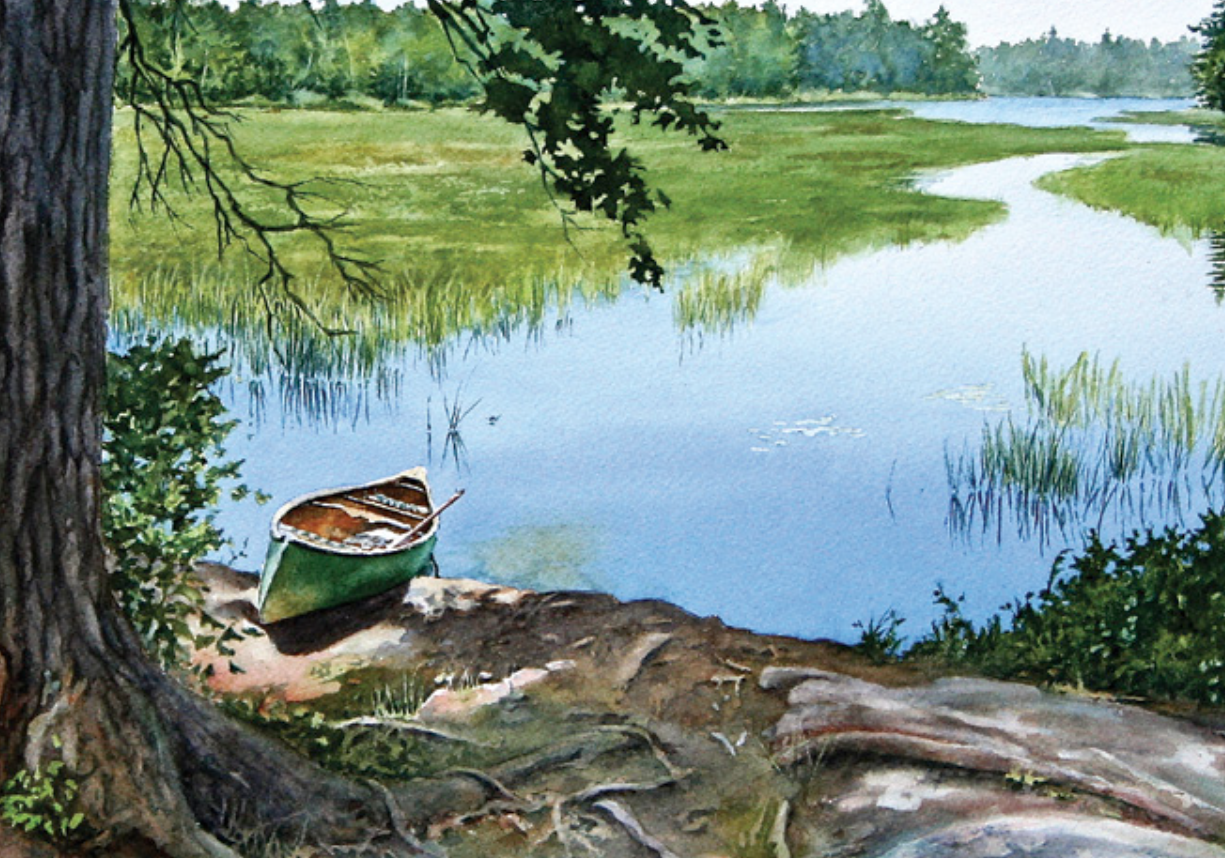
Sidler has painted since she was a child, but since retiring from her career as a primary school teacher after 34 years, she has had more time and more energy to devote to her artwork.
“I’ve been very lucky to be able to pursue this second career,” she says. “I now consider myself an artist and that’s an amazing goal to have reached. As a kid I always said I wanted to be an artist. Everyone was like, ‘Okay, but what are you really going to do?’”
When she’s not painting or keeping up with a busy exhibition schedule, Sidler is a longtime volunteer at the Canadian Canoe Museum, where replicas of her work are sold.
She says the most rewarding part about being an artist is when she sees viewers connect emotionally with her artwork.
“Traveling by canoe is an opportunity to journey into wilderness,” says Sidler. “You move in silence and peace, leaving behind only a trail of small waves. When you reach your destination you are tired but restored in spirit, and so appreciative of the beauty around you.” She believes it’s viewing that beauty and fragility of the natural world that creates a feeling of responsibility to sustain it for future generations.
“I hope my art encourages viewers to explore this beauty for themselves, and to accept stewardship of this land we have borrowed, so it remains for others to enjoy.”
See more of Nan Sidler’s art at sidlerart.com.

The Map Maker
Réal Bérard
He’s a local treasure, mapping a labyrinth of canoe routes that crisscross Manitoba, and inspiring countless paddlers to discover the wilderness via river byways.
Many consider Réal Bérard’s hand-drawn maps to be works of art. Not intended as navigational charts, each is annotated with Bérard’s illustrations, old trapper songs, botanical notes, recipes, historic anecdotes, biographies, as well as markings for every waterfall, rapid and portage—measured out in paces like the Voyageurs—along Manitoba’s rivers.

“When I first put my hands on one of his maps, I was transported to the rivers,” says Jonathan Berger of Philadelphia, author of the extraordinary The Canoe Atlas of the Little North. “His drawings give me my aesthetic lens through which I view the North.”
Bérard got his route mapping start when he snared a summer job with Manitoba’s Department of Natural Resources in 1962. That season his supervisor sent him and two others on a 500-kilometer canoe trip.
It was a dry summer and the canoeists were ostensibly to help extinguish any forest fires they came upon. The trip took a month, ending at the mouth of Berens River at Lake Winnipeg. They never saw a single forest fire.
In those days, conservation staff was required to keep daily logs, which Bérard dutifully did. A few years later, with Bérard now a full-time employee, the supervisor asked him to make a canoe route map from his notes and drawings, as a way of encouraging people to experience Manitoba’s wilderness.

Bérard made his first map, and filled in the margins with local lore and history. He continued mapping waterways for the province for the next 20 years, producing 13 maps to date. They include dominant rivers like the Assiniboine and Winnipeg, and well-known canoeing routes like the Bird and Manigotagan rivers. Most have a central theme specific to that area, exploring native culture or the fur trade for example.
A full-time artist since 1990, Bérard’s other artistic endeavors include being an award-winning ice sculptor. He has also been the political cartoonist for 30 years at La Liberté, a weekly Francophone newspaper in Manitoba.
And he still canoes. Last year, Bérard, 79, and a friend, an 82-year-old trapper, paddled for a week on a loop that starts on the Nelson River in Northern Manitoba. He is currently making a map of the little known route, which is an easy trip, accessible by road and without rapids. When asked if he isn’t a little old to be making such treks, he responded in his characteristically unconventional way: “I’d rather be eaten by wolves and ravens, than by maggots.”
Order Réal Bérard’s maps at www.paddle.mb.ca.
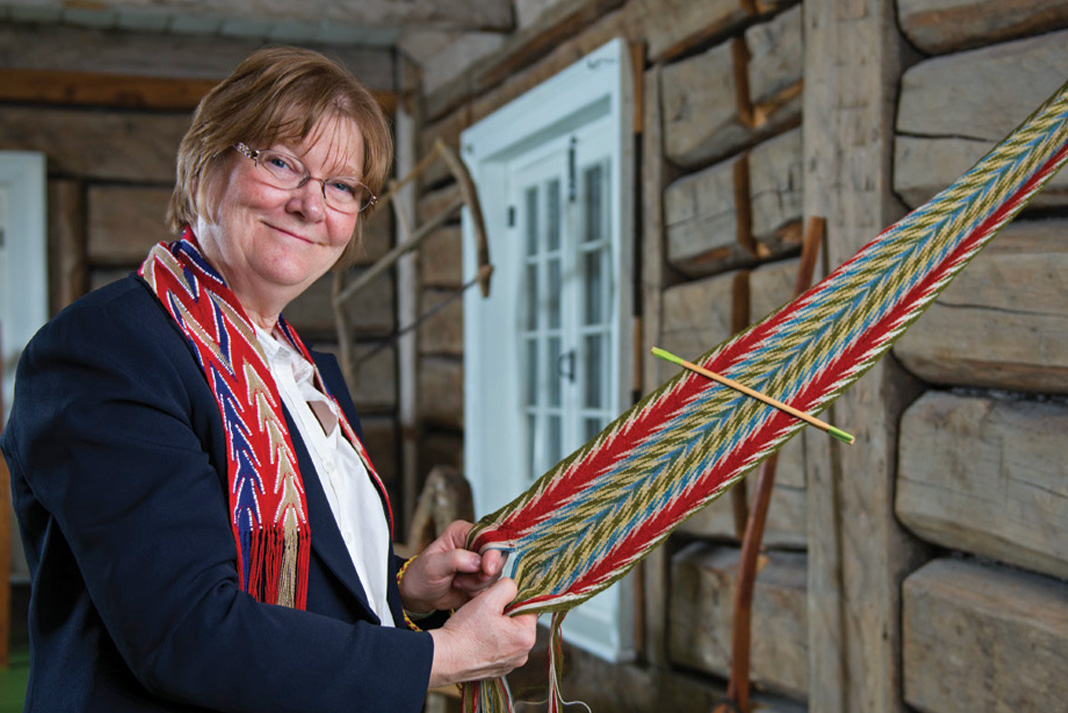
The Weaver
Carol James
The Voyageur’s most distinctive marker, the finely woven ceintures fleche, is a traditional art form kept alive by a handful of fingerweavers today, including Winnipeg, Manitoba’s Carol James.
These decorative sashes, worn by fur traders of The North West Company, were versatile tools for wilderness travelers, used as rope, pouches and for warmth. Some historians also believe they were used as core support to prevent hernias while portaging heavy loads.
Far more passionate about this textile technique than the canoeing-related history of the sash, James particularly loves the simplicity of fingerweaving—it’s done entirely by hand and requires nothing other than the yarn to weave and a hook on the wall.
James can weave about an inch per hour. The average finger woven sash takes about 60 hours to complete. Some sashes use as many as 286 individual strands. Depending on the type of yarn used, these one-of-a-kind pieces can sell for well over $500 per foot.
Her clients tend to be collectors and heritage connoisseurs. “The people who purchase these sashes clearly value the culture and history, and that type of traditional handcrafted work,” says James. She notes that there are machine-made replicas woven overseas that sell for just $20 to $30.
A former nurse, for three years James worked in the Artist in Healthcare program at the St-Boniface General Hospital in Winnipeg. She was stationed in the lobby where she practiced her art.
“The hospital was stunned at the response. People would come and just sit and watch,” she says. “Weaving creates an atmosphere of calm and harmony in a place where those feelings are hard to come by.” The meditative benefits James claims extend to the viewer, she says.
Fingerweaving helped her connect with many of the patients. “The sash plays a role in the heritage of three cultures that were represented in the hospital: the First Nations, the French and the Métis.”
James has always been interested in textiles, and could embroider and crochet before kindergarten. It was her French Canadian fiancé who introduced her to the ceintures fleche. He asked her to weave him one for their wedding to represent his heritage. James was excited to learn the new technique.
After a family move to Winnipeg in 1990, James began volunteering at Fort Gibraltar, where the annual Festival du Voyageur takes place, and fingerweaving in her role as a re-enactor there.
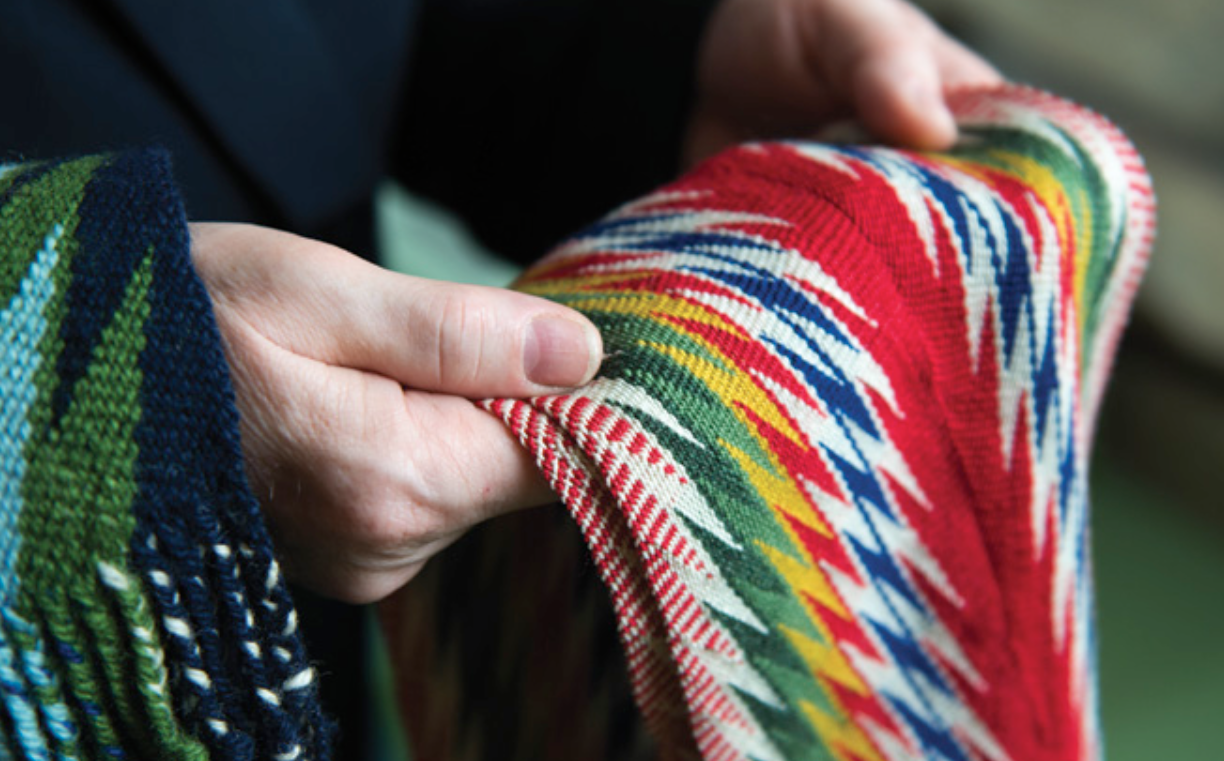
“I was the only one who either knew fingerweaving or was willing to attempt it again,” she says. She provided tutorials to teach other volunteers and was later asked to teach classes and create learning materials. That provided the inspiration to eventually publish her first book, Fingerweaving Untangled in 2008—the only English manual of its kind—and become a fulltime weaver.
James acknowledges learning the eye-hand coordination of fingerweaving requires a bit of commitment. “It’s like learning how to drive a stick shift, people say, ‘I can’t do it.’ But once you’ve done it a number of times, you do it without thinking. That’s when it can become relaxing and meditative,” she says.
As proof, James adds that she teaches basic fingerweaving techniques to grade school classes. “All the children end up with a bracelet by the end of class, which proves that anyone can do it. It just takes a bit of time to sit down and finger it out.”
Find Carol James online at sashweaver.com.
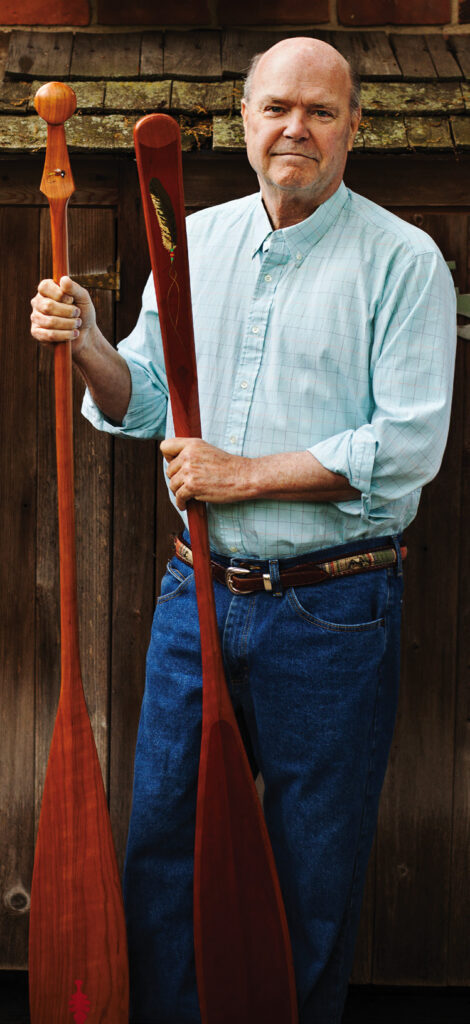
The Paddle Carver
Kent Lund
In the 12-by-12-foot wood shop behind his suburban Detroit home, Kent Lund spends hours carving and painting canoe paddles. The Michigan artisan prefers working with cherry, sassafras and curly maple woods. His decorated, often whimsical, designs are created for paddlers and art enthusiasts.
“It’s an addictive eye-hand, tactile thing,” Lund explains about the appeal of crafting custom paddles. “I like carving wood. Paddles are sculptures that you can use.”
Lund began carving them in 2000. His first was a traditional style, made from Sitka spruce. It was a gift to his son Max, an Eagle Scout headed for Minnesota’s Boundary Waters Canoe Area Wilderness.
“I wanted to give him something for the trip, something nice that fit well. I didn’t like the two-by-four paddles I saw out there,” Lund notes.
His wife and daughter soon requested one. Then other family members called asking. Word spread, but it was a few years before Lund considered it a business.
His unique designs were exhibited and won awards in 2012 and 2013 at Art Prize in Grand Rapids, Michigan, an international art competition. The exposure helped the fledgling business grow. Lund named it The Grand Rapids Paddle Company.
“My inspiration comes from North American Woodland Indians and the folk art of the canoe guides in the Adirondacks,” says Lund. “They carved by the campfire after a day of paddling. They fixed and repaired paddles in their free time.” Lund researches the style of vintage paddles, and many of his designs feature a lollipop-style grip, unique to Adirondack guide paddles.
A fulltime photographer by day, Lund carves an average of 12 paddles a year—he affectionately refers to the Grand Rapids Paddle Company as the smallest paddle maker in the world—each from a single piece of wood. After the paddle is carved Lund paints it—usually a design inspired by folk art or animals. Each paddle takes 40 to 60 hours to complete and sells for $200 to $550.
One memorable paddle was carved for a northern Michigan canoeing couple, he says. They wanted it made from a tree they had cut down. The planks from it had been drying in their barn for a decade.
“It was a crazy maple, old and unique,” Lund declares. He loved working with its many knots and grain. “I laid the pattern out the best I could to make it as pretty as possible.”
Lund’s regard for fine woodworking began at a young age while working at his father’s Detroit business where car parts were made from wood before being cast in metal. He was enamored with the precision tools and found the scrap bin provided a good opportunity. He began developing his skills first by creating toy boats and fishing lures.
“I try to make every paddle so you can use it,” Lund says. “A well designed tool is art. If it feels comfortable in the hand and works well—I think of it as a handsome tool.”
Find Kent Lund online at customcanoepaddle.com.
This article first appeared in the Fall 2015 issue of Canoeroots Magazine.
Subscribe to Paddling Magazine and get 25 years of digital magazine archives including our legacy titles: Rapid, Adventure Kayak and Canoeroots.



